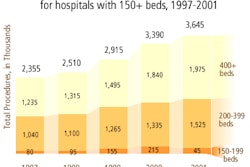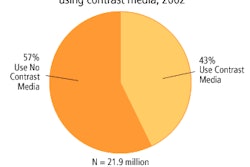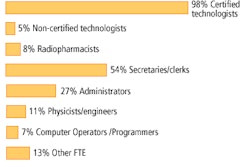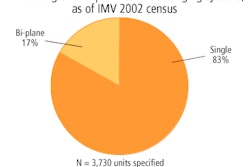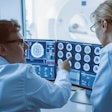The U.S. medical imaging market grew at an average annual growth rate (AAGR) of 11.5% in 2003 to hit $11.5 billion in revenues, according to market research and consulting firm Frost & Sullivan. Strong growth is expected to continue this year, climbing at an AAGR of 9.8% to reach $12.6 billion, a figure that marks a doubling of 1998 market revenues.
"Despite the continued presence of general economic woes and the decline of the dollar against global currencies, the U.S. medical imaging market continued to demonstrate that like many healthcare markets, it is somewhat shielded from negative economic effects," said Monali Patel, Frost & Sullivan medical imaging industry manager. She spoke during an industry briefing Thursday.
The 2003 market was characterized by diversification, with imaging modalities representing only 51% of total sales, according to the San Jose, CA-based firm. Equipment services turned in 23% of sales, while imaging agents contributed 16%. Imaging information technology yielded 10% of total sales, and is expected to command a greater share in the year ahead, Patel said.
While imaging is still primarily used to diagnose ailing patients, the technology is also increasingly being deployed for early detection, and for intermittent use between treatments to make sure a specific treatment plan is efficacious, Patel said. For example, cardiac imaging has contributed to a marked decrease and stabilization in the early mortality rate due to cardiac events over the last two decades, she said.
"The battles that have been won have not been won because the American public is leading a healthier lifestyle," Patel said. "Instead, they have been won as a result of medical technologies that allow for early intervention and treatment."
On the other hand, the war on cancer is getting tougher, as therapeutics have failed to produce hoped-for results despite research investments totaling billions of dollars. Instead, the majority of progress has generally been provided via early detection and treatment, which is again largely assisted by imaging technologies, Patel noted.
Looking ahead
In the future, medical imaging technologies are expected to appear at the forefront of medicine and are likely to show up earlier in the continuum of care, Patel said.
"Molecular imaging is playing a significant role in terms of medical imaging and the delivery of cutting-edge medicine," Patel said.
By segment, radiopharmaceuticals and contrast is expected to generate 23% of revenues, with MRI and CT to yield 15% and 14%, respectively. Imaging IT should provide 13%, with ultrasound and x-ray making up 12% and 10%, respectively.
Other segments include PET (7%), nuclear medicine (4%), mammography (2%), and digital radiography (1%), according to Frost & Sullivan. Segments growing the fastest include PET and PET/CT (40%), and imaging IT (18%).
2004 Trends
The adoption of imaging technologies by cardiologists, oncologists, and physician offices continues to grow and expand, providing vendors with sales opportunities for both core and novel imaging modalities, she said.
"Much of the expansion has been driven by product capabilities such as portability and the ability to perform minimally invasive and noninvasive procedures that have allowed products to be better suited for multiple uses within the hospital as well as within alternate-care facilities," Patel said.
Updates of technologies such as compact and cardiac ultrasound, as well as nuclear breast imaging and breast PET, have allowed for dissemination into new healthcare niches, she said. And large capital equipment purchases such as cardiac CT are also on the rise within the cardiology group market.
Imaging needs IT
In other trends, imaging IT has become a mandatory technology, driven by the sheer volume and complexity of imaging procedures. Neglecting needed IT upgrades will lead to lower productivity, more treatment mistakes, lower clinician morale, and higher personnel and staffing costs, Patel noted.
"While up to now, everyone has focused on the cost of implementing IT systems, it has now become apparent that the cost of not investing in sophisticated systems is high and will create a longer-term financial burden," Patel said.
Frost & Sullivan is also noting a mixed bag for early detection and screening measures. Among positive developments are the rise of virtual colonoscopy and the use of non-mammographic breast imaging devices, which make screening more appealing to patients, Patel said.
However, CT screening or wellness centers are declining, which may be indicative of a lack of readiness by the U.S. and its healthcare system for widespread screening measures, Patel said. And even for established applications such as mammography, controversy over the effectiveness of screening has led to sluggish growth.
With the drive towards early detection of disease, molecular imaging becomes increasingly critical, Patel said. Industry activities are heating up in molecular imaging, including acquisitions (such as Waukesha, WI-based GE Healthcare 's acquisition of Amersham of the U.K.) and alliances among other big players.
In addition, smaller market competitors are developing novel radiopharmaceutical agents designed to unveil activity or treat disease at the molecular level, Patel said. Frost & Sullivan has also identified growing activity in the small-animal imaging market, which is poised for rapid growth and adoption.
Vendors are also increasingly focusing on expansion and profitability in 2004, Patel said.
"On the expansion side, the global economy -- though stagnant in many regions of the world such as Japan -- is being balanced by burgeoning growth in markets such as China and India," she said. "China is hands-down the current global hot spot for medical imaging and is expected to continue to provide growth opportunities for several years to come."
In addition to sales opportunities, these nations also provide opportunities for manufacturing components and equipment at a lower cost, Patel said.
First-tier industry players are now focused on offering solutions aligned with disease states such as cardiology and oncology, moving away from the previous mantra of being total solutions providers, she said.
Market obstacles
Despite the bright outlook for the market, there are some challenging barriers for industry participants, including worldwide cost-containment measures, Patel noted.
These measures, particularly apparent in Europe and Japan, limit purchases of big-ticket capital equipment, Patel said. And within the U.S. market, the narrowing of product life cycles brought on by intense periods of innovation may also restrict sales. For example, a hospital that purchased a 16-slice CT scanner in 2003 would be hard-pressed to soon upgrade to a 32-slice system.
"By trying to outdo the competition in terms of offering the most advanced and latest and greatest technologies in the shortest amount of time, companies may find adoption barriers for high-end scanners," she said.
Turf battles are also a challenge for vendors to navigate, as a long-standing relationship with a hospital radiology department could be jeopardized by system sales to the cardiology unit, for example.
In addition, the aggressive cycle of acquisitions in the last three years have led to the near decimation of second-tier companies, and has made it hard for third-tier vendors to survive, Patel said. The third-tier companies, which have historically produced strong records of innovation, have had a hard time with sales, marketing, and distribution due to more limited resources, she said.
Ultimately, however, the clinical value of medical imaging continues to grow exponentially, pushing the technology into the heart of healthcare delivery and the practice of medicine, Patel said.
"The remainder of 2004 is expected to be a year of planning, implementation, and careful and calculated strategic deliberation about the shape of things to come," Patel said. "Companies are expected to increasingly focus on how medical imaging, molecular imaging, and IT innovations can come together to improve clinical and workflow outcomes in the years ahead."
By Erik L. RidleyAuntMinnie.com staff writer
May 10, 2004
Related Reading
European cardiovascular monitoring market on the move, March 2, 2004
European PACS market poised for growth on gains in enterprise sector, February 10, 2004
Affordable equipment accelerates ultrasound proliferation, January 26, 2004
Frost predicts tripling of non-mammo breast imaging in U.S., December 9, 2003
Frost sees growth in European equipment-services market, August 7, 2003
Copyright © 2004 AuntMinnie.com




